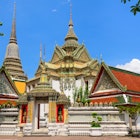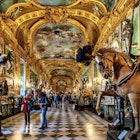

The central canal (Stora Hamnkanalen) through downtown Gothenburg. Andreas Bitterer / Getty Images
Gothenburg is Scandinavia’s largest port and sometimes lovingly referred to as Sweden’s ‘second city’. It’s best known for producing Volvos, but over the last couple of decades it has managed to reinvent itself as a modern travel destination.
Nowadays, cutting-edge design has replaced industrial grit in Gothenburg’s formerly run-down neighbourhoods. Warehouses and industrial buildings have been turned into art galleries, Michelin-starred restaurants grace the local dining scene, and independent coffee shops dot the city. Add a lively night scene and a string of peaceful islands right on its doorstep, and it’s easy to understand why Gothenburg is giving Stockholm a run for its money.

Welcome to the neighbourhood
Gothenburg is made up of a number of distinct neighbourhoods, so it helps to get your bearings early on. Its historic city centre is separated from the rest of town by a jagged moat. Vasastan is where you’ll find most of the art galleries. Gothenburg’s most important museums are found off Avenyn, the city’s main boulevard.
Trendy Magasingatan is the top spot for Swedish fashion brands, while the streets around Järntorget are filled with increasingly hip and ethnically diverse eateries. Of the city’s formerly hard-luck nooks, none have seen greater transformation than Haga, one Gothenburg’s oldest districts. Its cobbled streets are now lined with quirky shops and cafes and renovated wooden landshövdingehus houses.
Bordering Haga to the west is Linné; independent designer shops and al fresco patios are found all along Linnégatan boulevard. The adjoining ‘long streets’, such as Andra Långgatan have held onto their classic watering holes, which remain pleasantly down to earth.
Frihamnen, Gothenburg’s innermost harbour and port area, is at the forefront of the city’s rebirth. Partially derelict since 2000, it is being turned into Jubileumsparken – a new leisure park that will be a major part of Gothenburg’s 400th anniversary in 2021. Its features will include a man-made beach, a floating pool and a spectacular sauna, designed by the award-winning architect group Raumlaborberlin.
Art and design
Stockholm gets headlines for its all-enveloping design scene, but Gothenburg is no lightweight. The city boasts a treasure trove of trendy interior design shops in a compact area in the city centre. Places like Artilleriett/Artilleriet Kitchen, Rum 21, Floramor & Krukatös and many more make for an unbeatable day of décor inspiration.
For contemporary Scandinavian art, it’s hard to beat Galleri Ferm, Galleri Thomassen and Galleri Nils Åberg. Putting a defunct power station to good use, Röda Sten art centre is the city’s top alternative art venue, staging everything from edgy Swedish photography exhibitions to live music nights. And though it’s currently closed for renovation through the fall of 2018, the Röhsska Museum is the best design and applied arts museum in Sweden.
Cutting-edge architecture is also part of Gothenburg’s appeal. Kuggen (Lindholmplatsen), resembling a red Colosseum, is a marvel of green engineering, while the distinctive red-and-white skyscraper Göteborgs-Utkiken (a.k.a. The Lipstick) towers over the harbour and offers tremendous views from the top.
City of culture
As Volvo’s home of manufacturing, Gothenburg has an enduring relationship with the car company. Visitors can both take a tour of the car factory itself and immerse themselves in all things Volvo-related at the Volvo Museum. But there is much more to the city than car culture, including several world-class museums.
Science and technology meet the rainforest at the incredible Universeum. Meanwhile, the Konstmuseum’s art collection, spanning from the 15th century to the present day, is one of the finest in Europe. Stadsmuseum is the only place in Sweden where you can see an original Viking longship, while Sjöfartsmuseet explores the city’s more recent maritime culture. And once you’re all museum-ed out, head to Liseberg, Sweden’s largest amusement park, to unwind.
Where to eat
Gothenburg’s dining scene is defined by the abundance of fresh fish and seafood, caught off the west coast of Sweden. Swedish oysters, seasonal smoked prawns, grilled crayfish and catch of the day dominate the menu at local institution Restaurang Gabriel inside the legendary Feskekôrka (‘fish church’) fish market.
Other good places to sample the sea’s bounty include Fiskekrogen, locally beloved for over two decades for its shellfish platters, and Strömmingsluckan, a humble food truck at Magasinsgatan 17, serving nothing but freshly grilled herring with mash and lingonberries. The creative, seasonal menu at Michelin-stared Sjömagasinet focuses heavily on seafood, as do the multi-course tasting menus of its Michelin-anointed brethren, Koka and Thörnströms kök.
Seafood aside, Gothenburg’s diverse dining scene encompasses a multitude of world cuisines, from Thai and Ethiopian to gourmet hot dogs, with numerous chefs championing Sweden’s slow food movement as well. And if you’re looking to meet local foodies, visit the splendid Saluhallen (‘The Market Hall’) with some 40 delis and restaurants.
Bring on the night
From beer halls and wine bars to nightclubs and live music, Gothenburg takes its nightlife seriously. Neither has it escaped the craft beer explosion, with some of the bars and brewpubs found along Andra and Tredje Långgatan. Haket Pub represents most of the local microbreweries, Noba Nordic Bar, branches out into Norwegian, Danish and Icelandic brews, while creaky Ölhallen 7:an (Kungstorget 7) has been serving pints since 1900.
Mexican-brothel-inspired Puta Madre’s cocktails are as enticing as its crazy décor, while tiny Basque bar Juan Font pairs carefully selected wines with tapas. Going strong for years, Nefertiti is both a legendary jazz club and one of the city’s liveliest dance floors, while Lounge(s) has something for everyone on one of its many floors. For the underground music scene, check out illegalground.com to see what’s happening.

Island escape
If you get tired of the hustle and bustle of the city, catch tram 11 to Saltholmen boat terminal and take a boat to the southern archipelago – nine peaceful, car-free islands. Carved of granite and sparsely covered with greenery, they are ideal for long walks, bicycle rides, exploring villages and smokehouses or just sunbathing on the rocks. Brännö, Styrsö and Vrångö have guesthouses. Vrångö also has good swimming spots, as does tiny Vinga.
Practicalities
Gothenburg Airport is served by flights from numerous European cities, including London, Frankfurt, Munich, Helsinki, Amsterdam, Brussels, Copenhagen, Stockholm, Malaga, Paris, Prague and Istanbul. The city’s also reachable by train from Stockholm or Copenhagen (those rides are about three hours).
If you’re planning on doing a lot of sightseeing, it can be worth getting the Göteborg City Card, which gives you free entry to many attractions and includes bus, tram and boat travel. There’s a new Gothenburg Pass card available from 1 January 2018, though it doesn’t include public transportation.
Explore related stories


 FoodWinterful Copenhagen: finding the Christmas spirit in Denmark's capital
FoodWinterful Copenhagen: finding the Christmas spirit in Denmark's capitalDec 14, 2018 • 4 min read








